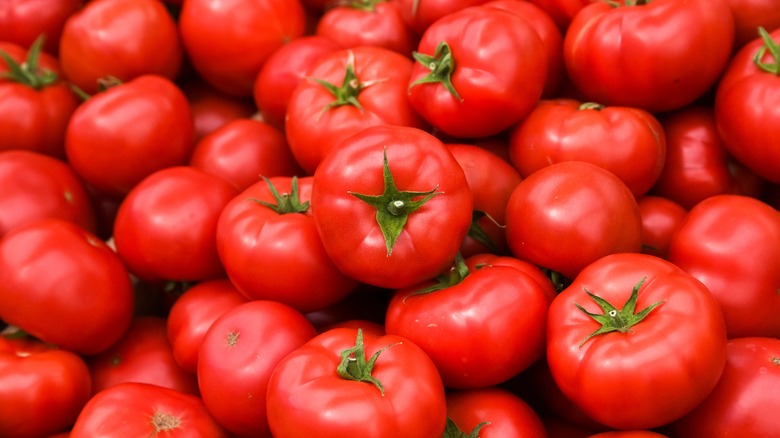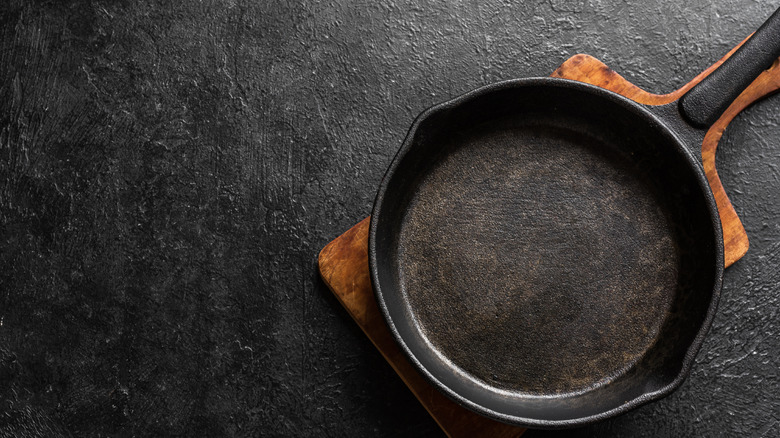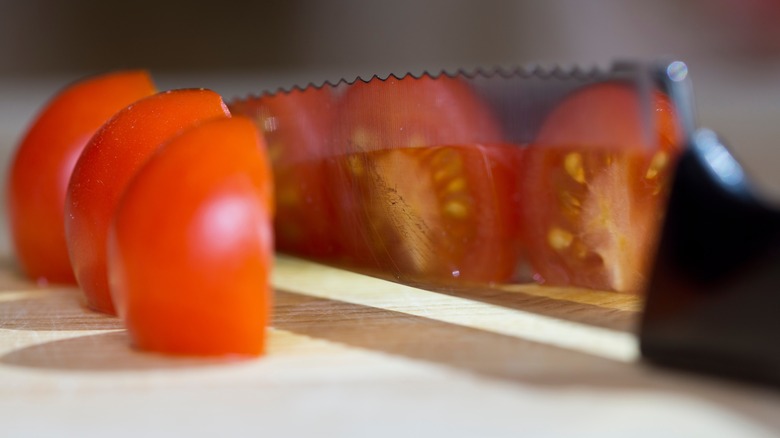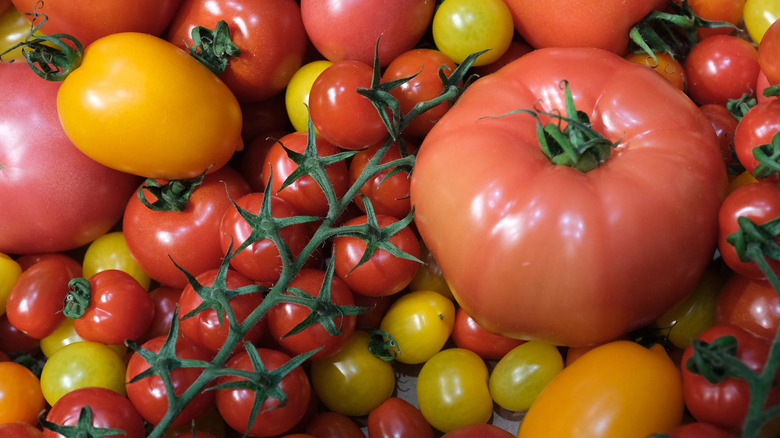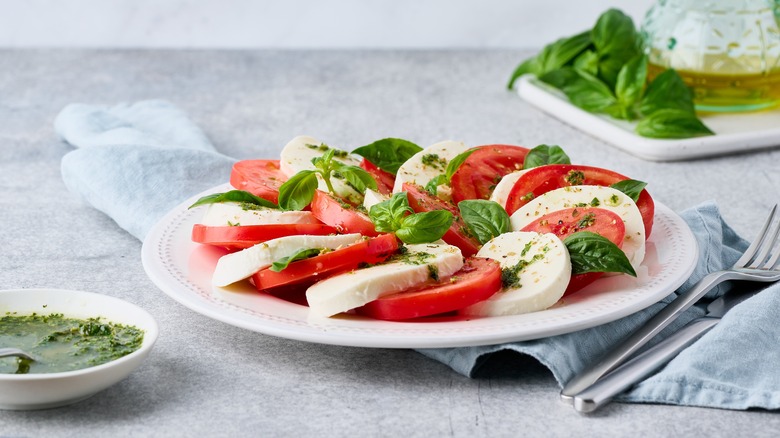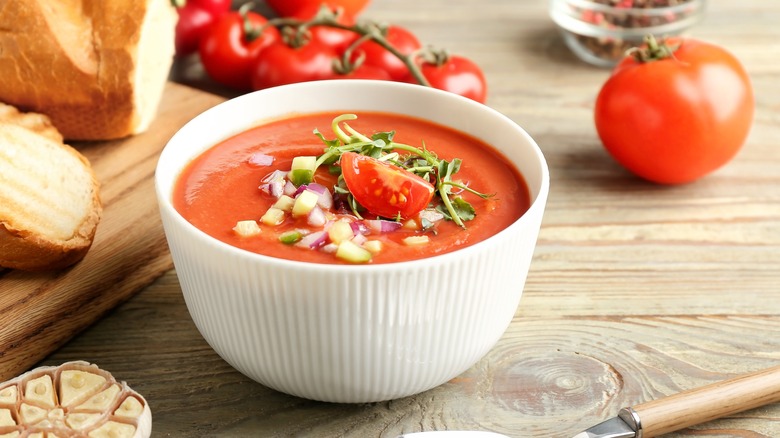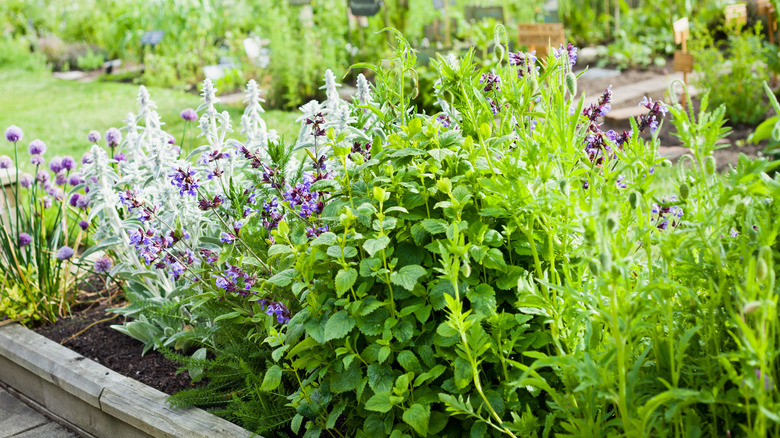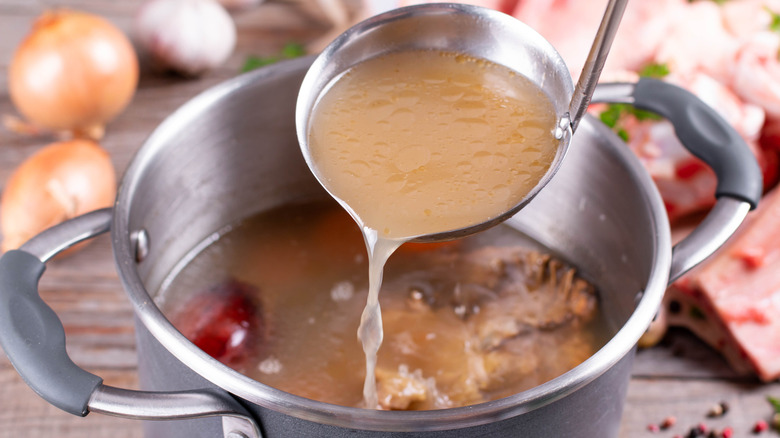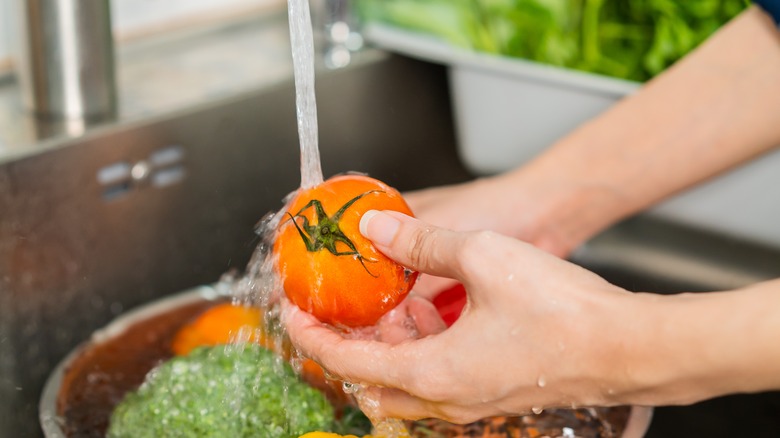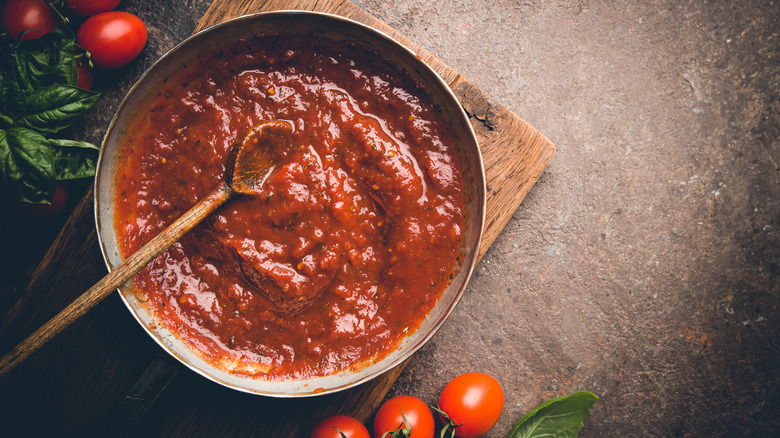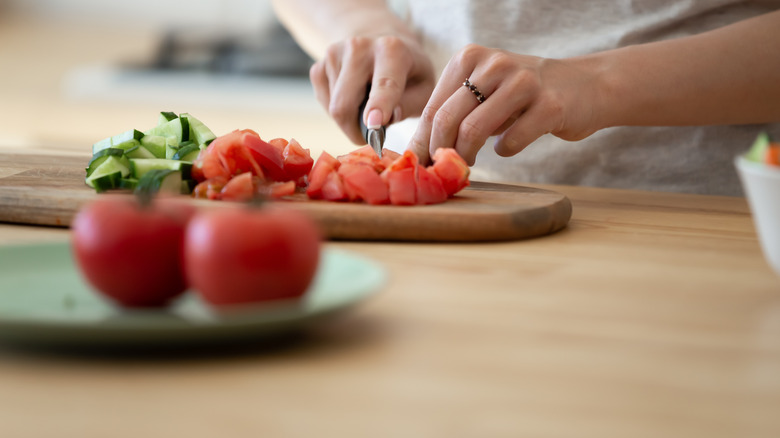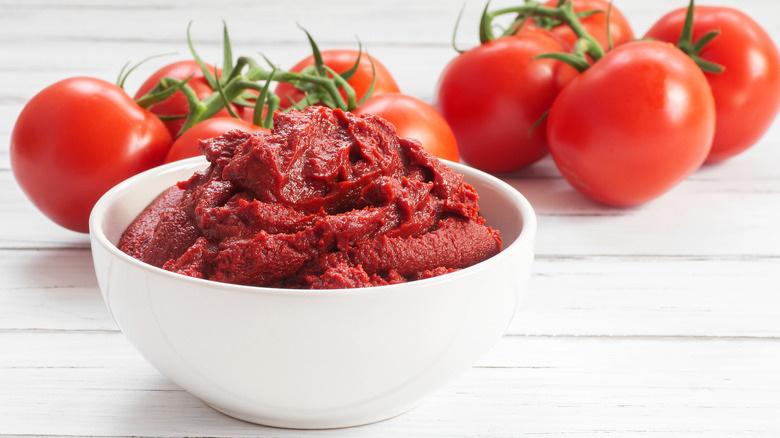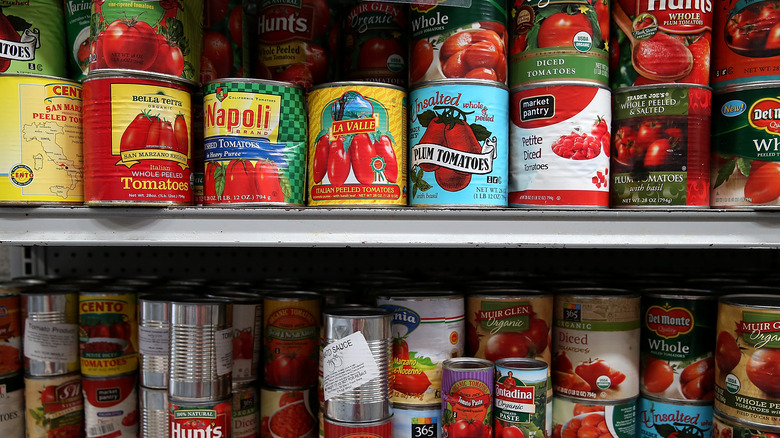The Biggest Mistakes You Need To Avoid When Preparing Tomatoes
Preparing tomatoes should be easy enough, right? Actually, not always. For a few reasons, the tomato preparation and cooking process can end up being a more complicated endeavor than you may have anticipated, and even experienced chefs can end up overlooking some of the fruit's idiosyncrasies.
Do tomato dishes you make sometimes taste too acidic? Do you have trouble evenly slicing tomatoes? Have you wondered about when it's best to use fresh tomatoes, versus when to use canned tomatoes? If so, read on. And remember: none of this suggests that you're using tomatoes the "wrong" way — or that there even is a wrong way to use tomatoes. After all, cooking competently takes practice and experimentation. That said, there are a variety of steps you can take when working with tomatoes to make your meals as tasty as possible, and avoid some of the pitfalls that come when using the fruit.
Using reactive cookware
Cast iron is considered one of the most reliable materials with which to cook. Well-made cast iron is versatile and strong, and with proper care, it can easily last decades. That said, it can impart iron into the food you are preparing, a process that is more likely to occur with acidic foods like tomatoes (via Livestrong). While a little iron is in most cases not too harmful — and besides, a well-seasoned cast iron pan is less likely to leach any iron at all — you can avoid all this by using a non-reactive pot or pan when cooking tomatoes.
The main difference between non-reactive and reactive cookware comes to down the inclusion of enamel coating. Reactive cookware lacks that layer of protection and can therefore interact with typically acidic foods to leach small amounts of metal into your food. (Along, with cast iron, cookware made from aluminum and copper falls under this category.) Aside from giving your food a metallic taste, over time the process of reaction can wear down your pot and pans.
Non-reactive cookware, in contrast, does not do this. Be sure to choose a non-reactive pot or pan made of materials such as stainless steel, ceramic, and glass to cook with tomatoes, and you won't damage your cookware or have to worry that the dish your cooking will end up with a metallic taste.
Not using a serrated blade to cleanly slice tomatoes
Maybe you've started to prepare tomatoes for a meal only to find that your usual chef's knife just doesn't cut it. Perhaps it isn't able to smoothly slice into the skin, leaving you with jagged-cut pieces, rough edges, or tomato innards everywhere.
It may not be obvious at first, but tomatoes can be quite cumbersome when it comes to slicing. Unlike a cucumber, an apple, or a head of lettuce, tomatoes frequently do not lend themselves to neat cuts with a standard knife. The best thing to do for your slicing and dicing needs is to reach for a serrated knife. (Specifically, superstar chef Thomas Keller recommends using a bread knife to cut tomatoes.) The sharp teeth on a serrated blade can help you cleanly break into the flesh, avoiding an ugly or a messy cut.
Whether you're trying to cut slices, wedges, or even do a small dice, a serrated knife can help you manage it cleanly without having to leave any of that precious pulp on the cutting board.
Sticking with the same varieties
A tomato is a tomato, right? Not necessarily. Actually, there are dozens and dozens of different types of tomatoes — from beefsteak and plum to multiple varieties of heirlooms — with all sorts of uses. While one type of tomato can more or less be substituted for another in most recipes, to understand the full depth of flavor of the fruit, you really need to explore beyond the full spectrum of options.
This is doubly important because different varieties lend themselves to different types of recipes. Large beefsteak and heirloom tomatoes are great for grilling (provided they're not too juicy and end up falling apart). On the other hand, small cherry and Sungold tomatoes can be served raw in a big salad but are also prime candidates for a pasta sauce.
So if you've just been buying common supermarket varieties your whole life, maybe it is high time to change things up.
Not eating your tomatoes raw
When you are working with tomatoes, it is essential to remember that they don't always have to be cooked. In fact, there are plenty of delicious and nutritious ways to serve raw tomatoes. ("Nutritious" is key here, because tomatoes, cooked or not, are very good for you: They contain vitamin C, lycopene, antioxidants, and more, per Healthline.)
What's the best way to eat them au natural? Well, it honestly depends on the season (don't forget, tomatoes are a summer fruit, typically ripening between June and September), the type of meal, the number of guests you are inviting over for dinner, and your own personal preferences. For a really simple, sharable dish, try pan con tomate: Slice tomatoes thin or into wedges, and rub them on toast with a little salt on top. On a hot afternoon, serving sliced tomatoes solo with a little balsamic and sea salt is another good option. Better yet, pair your raw tomato with slabs of fresh mozzarella and whole basil leaves for a refreshing caprese salad.
Putting together a BLT or adding a slice of tomato to a burger are tried and true for a reason, but if you want a hearty meatless option, take a cue from José Andrés and construct a beefsteak tomato sandwich with herbed mayo, pickled onions, and alfalfa sprouts. Don't be afraid to experiment, and always keep in mind — tomatoes are delicious both cooked and uncooked.
Not making cold tomato soups
You don't have to keep your tomatoes raw to enjoy them at a cool temperature. While the classic hot tomato soup does the trick any time of year (especially when paired with grilled cheese), during the summer, we recommend chilling out. Cold tomato soups are one of the simplest "cooked" recipes to make with tomatoes. The most basic options for a cold tomato soup involve little more than tomatoes, water, garlic, a little vinegar, and potentially some seasonings (and, ideally, a food processor).
For a more international twist, consider making gazpacho — a staple of Spanish cuisine, typically made with tomatoes, cucumbers, peppers, old bread, and a few other ingredients. These are all delicious and refreshing options for a hot summer day (or really, anytime at all). Served with a sizeable hunk of fresh bread on the side in order to sop up every last drop, you'll have it made.
Not considering supplementary seasonings
Tomatoes can hold their own solo, but you may want to consider seasoning them and choosing herbal accompaniments that will complement the rich, sweet, and savory taste of the fruit. One of the best ways to do so — particularly in summer, when you can get them fresh — is by using herbs like basil, thyme, oregano, rosemary, and marjoram which pair deliciously with tomatoes, helping to bring out the earthy notes in the fruit. In fact, it's very popular to grow tomatoes alongside basil, as the two types of plants may have beneficial effects with respect to each other: some think that basil's smell deters insects that might damage tomato plants (via SFGate).
Perhaps best of all, herbs have a number of health benefits of their own which vary from herb to herb (via Today). For instance, basil has polyphenols, thyme contains vitamin C, and rosemary offers calcium and iron. There are plenty of unique and tasty ways to combine herbs, so experiment on your own to find the combinations that work best for you. And don't stop there — basic seasonings like salt and pepper are also essential, with salt drawing out the rich fruitiness of the plant, while pepper adds a nice kick to whatever you're making.
Throwing away your scraps
Even the unused parts of the tomato have some value. If you are preparing a recipe that calls for peeling tomatoes, discarding seeds, or otherwise only using part of the fruit, don't throw what you're not using. One of the best ways to use up your vegetable scraps (or in this case, fruit-that's-often-confused-as-a-vegetable scraps) is to add them to soup stock.
Never made broth or stock? It's simple to prepare and easy on the wallet. All you have to do is save your cuttings — most effectively, in your freezer — until you have enough to boil with water. (Meat bones and any variety of additional seasonings can also join the fun.) While scraps from celery, onions, and herbs like parsley and thyme are often the most important when making stock, tomatoes can also be a really tasty addition. You can even use produce scraps to upgrade store-bought stock. Taking advantage of scraps is also a great way to cut down on food waste and get the most out of your produce.
Forgetting to wash tomatoes beforehand
The FDA reports that nearly 50 million people are sickened annually with some type of illness caused by unclean food. The causes can vary, from human contamination in the harvest or shipping process to animal contamination while the food is growing, to other causes that can occur anytime from the farm to the grocery store.
In short, food contamination, unfortunately, happens a lot, including with tomatoes. With this in mind, whether you are cooking your tomatoes or eating them raw, don't forget to wash them first. In fact, even if they're grown locally, or are organic, they can still have residues of pesticides and other harmful substances — like dangerous bacteria — so rinsing is always vital. The FDA recommends that following other hygienic steps, like washing your hands thoroughly before cooking, and storing foods at the proper temperatures, are also essential to practice, and can help prevent any food-borne illness from occurring.
Making your tomato sauce too bitter or acidic
Buying a jar of delicious pasta sauce is nice and easy, and certainly helps when preparing a quick meal — but tomato sauce is especially satisfying to make from scratch. Of course, it's not always simple. In fact, maybe you've tried and found that your sauce is just a little too tangy, a bit too astringent, or acidic?
You may start to worry you did something wrong, but the truth is bitter or acidic homemade tomato sauce, high in ascorbic acid, is actually pretty common (via Livestrong). Fresh tomatoes can often produce a super tangy sauce, and it's necessary to make some corrections to help mellow out the flavor.
There are a few methods you can use to fix bitter or acidic tomato sauce, but adding a little bit of baking soda or sweetener (like sugar, or potentially even maple syrup) are two of the simplest ways to make a difference. This can help to balance out the flavor of the sauce, making it more palatable and mild for whatever dish you're preparing.
Keeping in the seeds and peels
Though it may seem counterintuitive given how seedy tomatoes are, taking out the seeds — as well as peeling your tomatoes — can actually be really important for perfecting a number of dishes. Why get rid of the seeds and skin? Well, seeds can sometimes lend an unpleasant texture to tomato dishes, while the texture of skins can sometimes be unpalatable in others. Perhaps even more importantly, the mushiness of tomato innards — while often acceptable in many soups and sauces — can be distracting in dishes where the tomatoes require a firmer texture.
Luckily, removing skins and seeds is a simple process. One of the easiest ways to peel tomatoes is to first blanch them in boiling water, and then cool them rapidly. This will ensure the skins can be removed without any issues and the tomato can be sliced and the seeds scooped out. Of course, remember to save your scraps for the next time you prepare a stock.
Taking tomato paste for granted
There are lots of interesting ways to work with fresh tomatoes but make sure not to take tomato paste for granted. Though you likely have a tube or can of it in your pantry, you might know exactly what tomato paste is. Well, it is essentially boiled down and reduced tomato sauce. It can be effectively used to impart strong tomato flavor to dishes, without having to deal with the liquid that is a constant when using canned or fresh tomatoes.
In practice, tomato paste can be a great ingredient, even in small doses, for thickening up soups and sauces while imparting a robust flavor. Try using it in marinades and braises for some added tomato intensity. Keep in mind that a goes a long way and if you're cracking open a can, you'll likely end up with leftovers. If that's the case, not to worry — simply freeze your tomato paste in tablespoon-sized portions for later use.
Not using canned tomatoes
Naturally, there is nothing like a delicious, fresh tomato, ideally plucked right off the vine or purchased at a local farmer's market, if possible. But while some people think fresher is always better, canned tomatoes actually should be a constant in any chef's pantry.
Why use canned instead of fresh? Canned tomatoes tend to be milder and less acidic than fresh tomatoes, and can help keep your sauces and soups from becoming astringent — which can happen sometimes with fresh tomatoes. They are also available in a number of options including whole stewed tomatoes, diced tomatoes, fire-roasted tomatoes, and tomatoes flavored with basil and other herbs.
Convenience is a major factor here. Using canned tomatoes is as simple as popping off the lid and putting them into whatever dish you're preparing. This can allow you to focus more time and energy on other parts of your recipe, without sacrificing flavor or quality. Plus, canned tomatoes can always be used year-round, allowing you to enjoy the benefits of tomatoes even in the deepest parts of winter.
